| Contents
Home
General
Info
Ordering
Info
Contact us
Cartridge
Lists
Patent & Miscellaneous
Rim Fire
Center Fire Pistol
Center Fire Rifle
Metric Rimfire,
Pistol&Rifle
British Pistol and Rifle
Shotgun Shells
Posters
This Month's Picture Page
Index to
Picture Pages
Prior Picture Pages:
*
September 2003
*
October 2003
*
November 2003
*
December 2003
*
January 2004
*
February 2004
*
March 2004
*
April 2004
*
May 2004
*
June 2004
*
July 2004
*
August 2004
*
September 2004
*
October 2004
*
November 2004
*
December
2004
*
January 2005
*
February
2005
*
March
2005
*
April
2005
*
May 2005
* June 2005
* July 2005
*
August 2005
*
September
2005
*
October 2005
*
November 2005
*
December 2005
*
January 2006
*
February 2006
*
March 2006
Links to Other Sites
Cartridge Collectors Organizations:
IAA
ECRA
SAAACA
Auctions:
Auction
Arms
E-Bay
Ward's Collectibles
Sold USA
Books:
Armory
Publications
WCF Publications
Other Collector's Sites:
Curtis Steinhauer
|
Home of the Old Ammo Guy's Virtual
Cartridge Trading Table
Featuring a wide range of antique,
obsolete, and modern ammunition for collectors
Picture
Page
April
2006
An experimental that's pretty easy to spot....
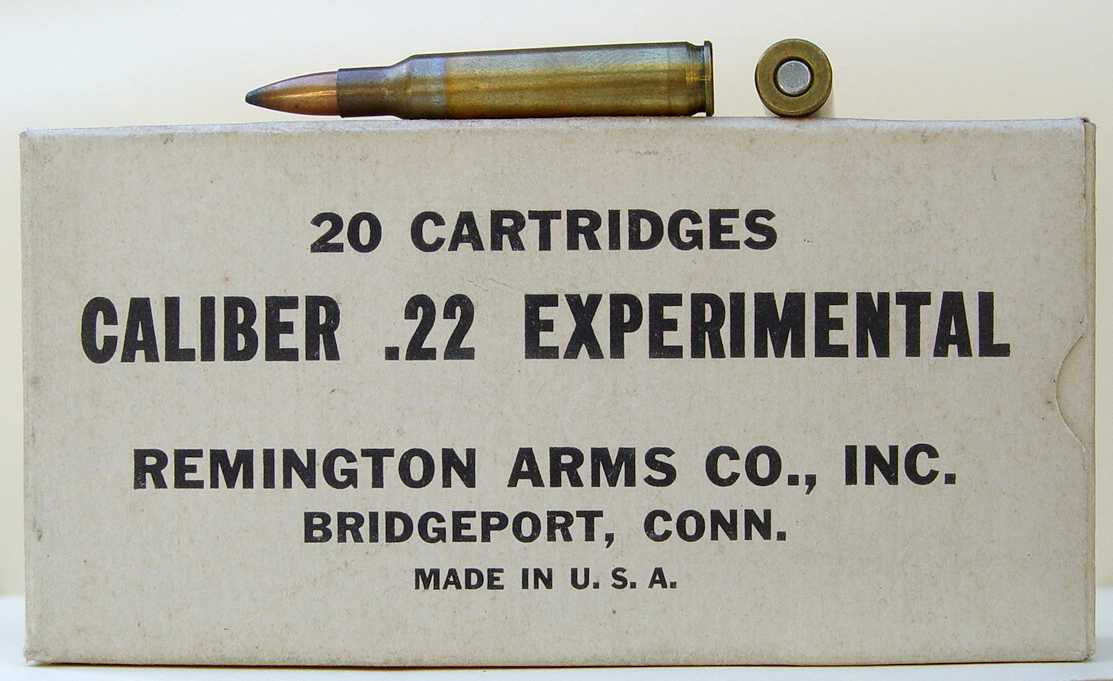 Here's
a box that should be relatively easy to spot as something special, with that
big, bold 'EXPERIMENTAL' on the front. I suppose the only thing missing is a
large, multi-colored neon sign saying 'HEY!! LOOK HERE!!'. This is a box full of
.22 Remington Experimental (surprised?)
cartridges, intended for use in the .224 Springfield Infantry Rifle, of
which only two prototypes were made. The cartridge was based on a lengthened
.222 Remington case with a higher shoulder, and was developed in the
mid-1950s as a cooperative effort between Remington Arms Company and the
Springfield Arsenal. The Remington Arms Company, which referred to the cartridge as the .22
Remington Experimental rather than the .224 Springfield perhaps as a means of deflecting unwanted publicity
away from the government project, produced 10,000 of these unheadstamped
cartridges for use by the Army in the .224 rifle tests. Because of a
perceived conflict with the Army's M14 program, testing of the .224 rifles
at the Springfield Arsenal was suspended in 1957. Recognizing that the
cartridge might have some potential as a hunting cartridge, Remington
introduced a commercial version in 1958 as the .222 Remington Magnum.
Unfortunately, it never caught on with shooters, and is produced only by
Remington at this time. The first three cartridges shown
in this picture are, from the left, the .222 Remington, the .224 Springfield
(aka .22 Remington Experimental) from the box, and the .222 Here's
a box that should be relatively easy to spot as something special, with that
big, bold 'EXPERIMENTAL' on the front. I suppose the only thing missing is a
large, multi-colored neon sign saying 'HEY!! LOOK HERE!!'. This is a box full of
.22 Remington Experimental (surprised?)
cartridges, intended for use in the .224 Springfield Infantry Rifle, of
which only two prototypes were made. The cartridge was based on a lengthened
.222 Remington case with a higher shoulder, and was developed in the
mid-1950s as a cooperative effort between Remington Arms Company and the
Springfield Arsenal. The Remington Arms Company, which referred to the cartridge as the .22
Remington Experimental rather than the .224 Springfield perhaps as a means of deflecting unwanted publicity
away from the government project, produced 10,000 of these unheadstamped
cartridges for use by the Army in the .224 rifle tests. Because of a
perceived conflict with the Army's M14 program, testing of the .224 rifles
at the Springfield Arsenal was suspended in 1957. Recognizing that the
cartridge might have some potential as a hunting cartridge, Remington
introduced a commercial version in 1958 as the .222 Remington Magnum.
Unfortunately, it never caught on with shooters, and is produced only by
Remington at this time. The first three cartridges shown
in this picture are, from the left, the .222 Remington, the .224 Springfield
(aka .22 Remington Experimental) from the box, and the .222
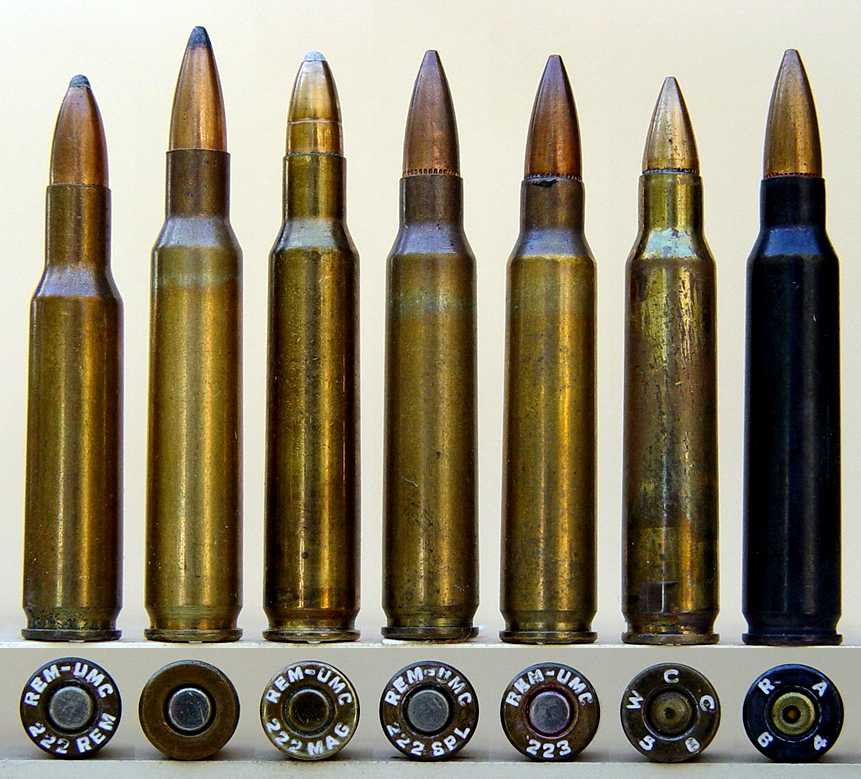
Remington Magnum. The remaining four cartridges are steps in the evolution
of the .223 Remington, the cartridge designed for use in the M16 rifle, which first saw service
in Vietnam in 1963, and which was adopted by NATO as the standard rifle
cartridge for use by its member nations in 1980. Remington also played a
major roll in the development of the .223 cartridge, working closely with Armalite's chief engineer Eugene Stoner
to come up with the best cartridge for their prototype weapons. The
cartridge that resulted was initially
called the .222 Remington Special. The first lot of cartridges was produced
in 1957 with the headstamp REM-UMC 222. The next headstamp used was REM-UMC
222 SPL, as is seen on the fourth cartridge in the picture. In 1959, the
headstamp was changed to REM-UMC 223. The fifth cartridge has this headstamp,
which was used until 1963, after which headstamps assumed the military style
with the manufacturer's initials (R A) and two digits for the year (6 3), as
seen on the last cartridge in the picture, which is a dummy made by
Remington in 1964. The sixth cartridge in the picture with the W C
C 5 8 headstamp is a .224 Winchester E2, which was that
company's developmental version of the.223 cartridge. It is interesting to
note that, like the .224 Springfield, the .223 cartridge design was also
based on the .222 Remington case, and although the .223 case is a little
shorter than the .224, the shoulders of the two match pretty closely.
..
.A 11mm Japanese Murata cartridge ...... ....

.Aside from the all-too-familiar crop of lead oxidation that is
slowly devouring the bullet, this is a nice example of what proved to be a
difficult cartridge to add to my collection. This one bears a headstamp
indicating production in the 17th year (1885) of the reign of Japanese
Emperor Meiji.
.
.
.
.
.
.
.
Too much of a good thing ...............
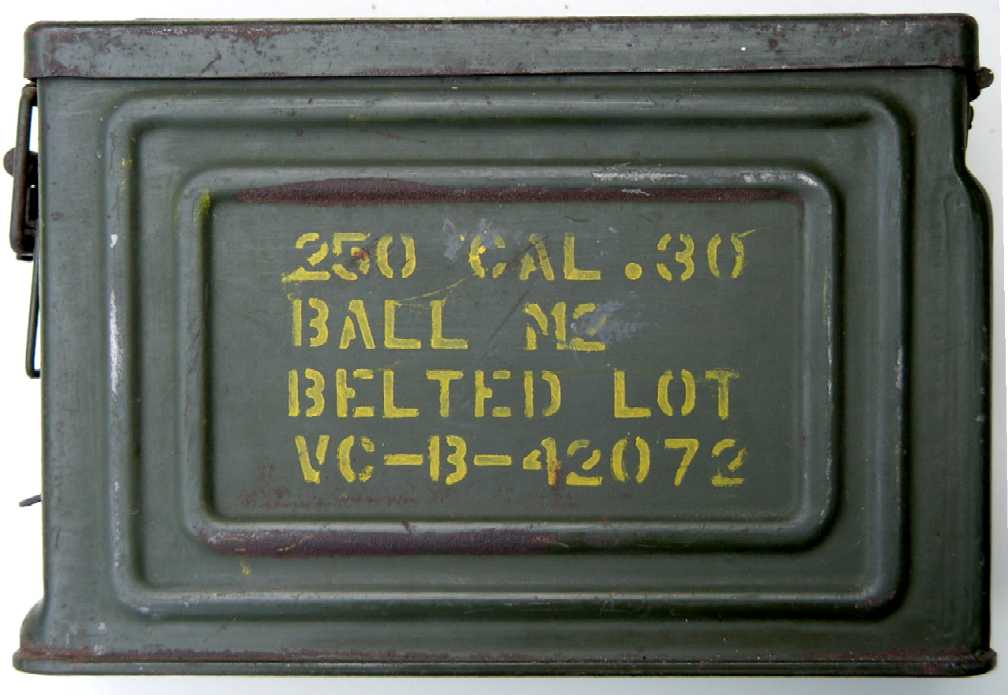
.Ten or 15 years ago, someone stumbled across a full crate of 15mm
pinfire and severely dampened the market for these once rare cartridges that
at one time were bringing $40 to $50 apiece for even the most common
varieties. Several years ago, large quantities of the experimental 4.6 x 36
HK CETME spoon tips and 4.9 x 45 DAG were imported into the US, dropping the
collector value for these cartridges from around $50 each to just $1 to $2
each. Here's a similar but somewhat less drastic example, this being a
nearly full 250 count can of belted .30-06 M2 ball cartridges with the once
uncommon V C 4 5 headstamp.
They were produced at the Verdun ammunition plant of Defense Industries
Limited (D-I-L), a subsidiary of Canadian Industries Limited (C-I-L) in
Montreal, Quebec, Canada. The cartridges are in an unmarked olive green
cloth machine gun belt. At one time, these cartridges sold for as high as
$15 each in Robert Buttweiler's cartridge auctions; current value is around
$4 each.
.
.
.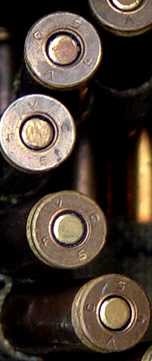
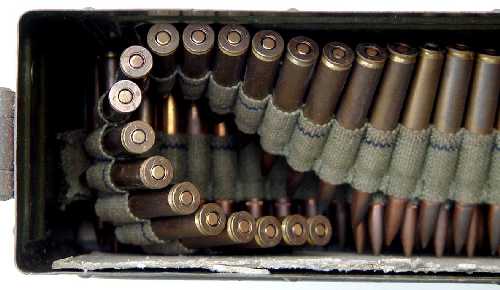
.
.
.
.
.
.
.
.
..
.
.
.
.
|

 Here's
a box that should be relatively easy to spot as something special, with that
big, bold 'EXPERIMENTAL' on the front. I suppose the only thing missing is a
large, multi-colored neon sign saying 'HEY!! LOOK HERE!!'. This is a box full of
.22 Remington Experimental (surprised?)
cartridges, intended for use in the .224 Springfield Infantry Rifle, of
which only two prototypes were made. The cartridge was based on a lengthened
.222 Remington case with a higher shoulder, and was developed in the
mid-1950s as a cooperative effort between Remington Arms Company and the
Springfield Arsenal. The Remington Arms Company, which referred to the cartridge as the .22
Remington Experimental rather than the .224 Springfield perhaps as a means of deflecting unwanted publicity
away from the government project, produced 10,000 of these unheadstamped
cartridges for use by the Army in the .224 rifle tests. Because of a
perceived conflict with the Army's M14 program, testing of the .224 rifles
at the Springfield Arsenal was suspended in 1957. Recognizing that the
cartridge might have some potential as a hunting cartridge, Remington
introduced a commercial version in 1958 as the .222 Remington Magnum.
Unfortunately, it never caught on with shooters, and is produced only by
Remington at this time. The first three cartridges shown
in this picture are, from the left, the .222 Remington, the .224 Springfield
(aka .22 Remington Experimental) from the box, and the .222
Here's
a box that should be relatively easy to spot as something special, with that
big, bold 'EXPERIMENTAL' on the front. I suppose the only thing missing is a
large, multi-colored neon sign saying 'HEY!! LOOK HERE!!'. This is a box full of
.22 Remington Experimental (surprised?)
cartridges, intended for use in the .224 Springfield Infantry Rifle, of
which only two prototypes were made. The cartridge was based on a lengthened
.222 Remington case with a higher shoulder, and was developed in the
mid-1950s as a cooperative effort between Remington Arms Company and the
Springfield Arsenal. The Remington Arms Company, which referred to the cartridge as the .22
Remington Experimental rather than the .224 Springfield perhaps as a means of deflecting unwanted publicity
away from the government project, produced 10,000 of these unheadstamped
cartridges for use by the Army in the .224 rifle tests. Because of a
perceived conflict with the Army's M14 program, testing of the .224 rifles
at the Springfield Arsenal was suspended in 1957. Recognizing that the
cartridge might have some potential as a hunting cartridge, Remington
introduced a commercial version in 1958 as the .222 Remington Magnum.
Unfortunately, it never caught on with shooters, and is produced only by
Remington at this time. The first three cartridges shown
in this picture are, from the left, the .222 Remington, the .224 Springfield
(aka .22 Remington Experimental) from the box, and the .222




